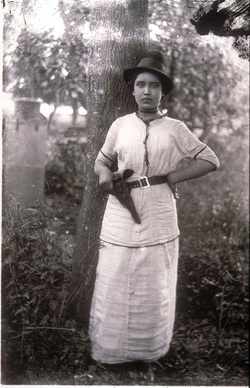The Corrido and The Mule Tamer
 Agustín Víctor Casasola In The Mule Tamer III, Marta's Quest, Rebecca and Marta sing the famous Corrido La Adelita.
Agustín Víctor Casasola In The Mule Tamer III, Marta's Quest, Rebecca and Marta sing the famous Corrido La Adelita. According to Poemas del rio wang; "This is one of the most famous Mexican corridos. The Revolution was not only the case of the soldiers. The troops were also followed by women and children who took care of the solders and feeded them, healed the ill and the wounded, etc.
The corridos are the Mexican offsprings of the Spanish romance. They express feelings and ideas, triumphs and defeats, pains and happiness which are so overflowing to constitute a collective importance for the Mexican folk. The corrido is the language of the people. At one time it played the role of the press: the news used to spread all over the countryside in songs, rather than in newspapers which were no important sources of information in an overwhelmingly illiterate country. Only the most important events or the great personalities deserved to be sung about in a corrido, but they sometimes also immortalize scenes of the everyday life of the internal parts of the country.
The corrido is characterized by spontaneity, and by a simple language and melody. It uses few poetic tools, but it is very concise, and gives more importance to the rhythm than to the form. Its classical form is the quatrain 8a 8b 8a 8b which also permits more than one poems to be sung with the same melody. This is why they can also easily be modified and actualized, so that one corrido lives on in several versions.
According to the man of letters, politician, speaker and poet of native Mexican blood Andrés Henestrosa, the circumstances favorable to the birth of the corrido were provided by the formation of national feeling and identity. It was born together with the Independence, but it reached its climax during the Revolution, with the collective rejection of “Porfirism” that took its name from the Mexican dictator Porfirio Díaz (1876-1911) and of forced Europization (Díaz was one of the great promoters of French culture among the Mexican high society). This was the longest and most supported phase of national rebirth, the one with the deepest roots in Mexican reality, and therefore the most popular one."
Published on September 08, 2012 18:35
No comments have been added yet.



